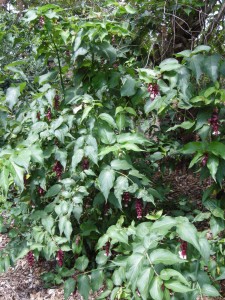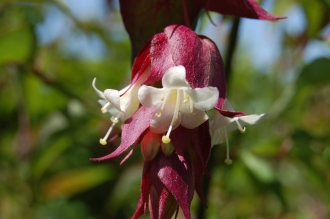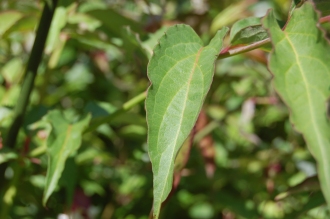Position: Full sun to partial shade
Soil: Moist, well drained soil
Flowering period: Summer to autumn
Eventual Height: 2m
Eventual Spread: 2m
Hardiness: 7a, 7b, 8a, 8b, 9a, 9b
Family: Caprifoliaceae
Leycesteria formosa is a deciduous shrub with an upright habit. Its hollow stems are round and green and persist into the winter months. Its blue-green shoots bear ovate, dark green leaves with pointed tips and gently lobed margins. In summer and early autumn it bears small, hermaphroditic, funnel shaped, white flowers at the tip of each cluster of purplish-red bracts and these are followed by spherical, reddish-purple fruits that will ripen a few at a time.
Leycesteria formosa, commonly known as Himalayan Honeysuckle and Pheasant Berry, is native to the Himalayas and south-western china. It has been in cultivation in the west since 1824 and some cultivated lines have sweet, chocolate flavoured fruit, with others being bitter and unpalatable. It is considered a noxious invasive species in, among other places, Australia, New Zealand, the neighboring islands of Micronesia. Its hollow stems have also been used to create wind instruments such as flutes and whistles.
Leycesteria was named for William Leycester (1775-1831), a horticulturalist and magistrate in Bengal, India. Formosa from the Latin meaning ‘beautiful’.
The landscape architect may find Leycesteria formosa useful as a low maintenance attractive shrub. Once established it is drought tolerant. It is tolerant of maritime locations. As its common name, Pheasant Berry, suggests this plant may be used a part of a plant mix to provide cover and food for Pheasant in rural locations.
Ecologically, Leycesteria formosa will attract pollinating insects such as butterflies and honey bees and birds or other animals may feed on its fruit, however; as this plant is not native to this continent these associations may not be prolific.
The Royal Horticultural Society gave Leycesteria formosa their prestigious Award of Garden merit in 2002.
Leycesteria formosa will tolerate almost any soil conditions; it will be happy at neutral, acid or alkaline pH levels, in loam, clay, chalk or sand based soils facing any sheltered aspect.
Leycesteria formosa requires little maintenance. It may be pruned after flowering to encourage new growth and prolong the life of the plant. Weak shoots may be cut back to the ground in spring to encourage more fruit. This plant may be propagated by division from March to May or by seed sewn in September to November.








